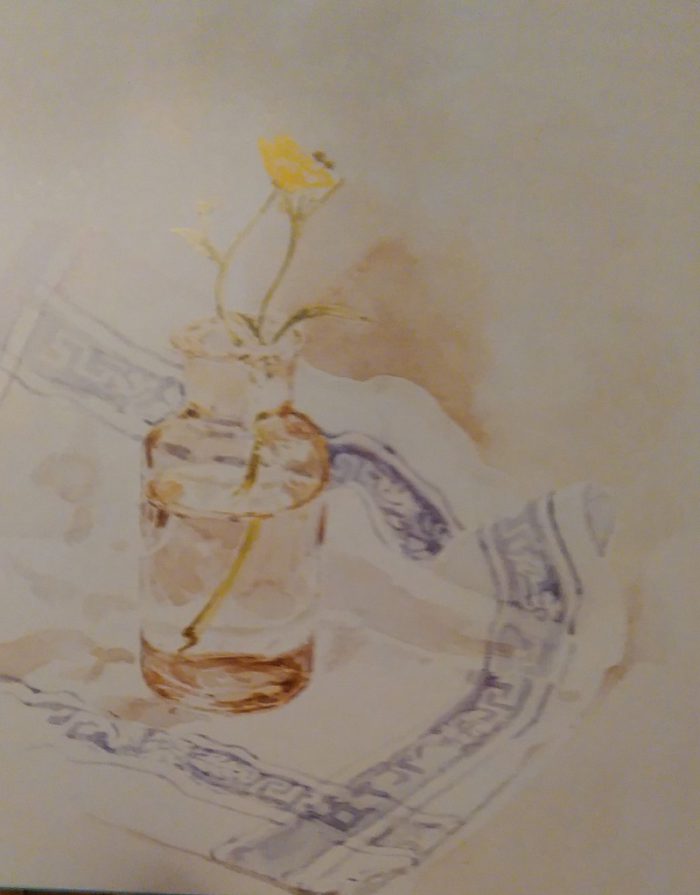Painting glass objects with watercolors can seem discouraging at first. But if you start to simplify objects the problem can be overcome. How to paint glass objects?
Painting of glass is very similar to painting of water, fewer details express more. Just a few laminated areas and reflections in the right places is enough to create convincing image of pure shiny glass.
For the beginning you will need the following:
- One sheet of cold pressed watercolor paper
- Round sable bristle brush number 3
- Round sable bristle brush number 5
The color you will need are:
- Raw Sienna
- French Ultramarine
- Alizarine Red
- Sky Blue
- Dark Green
- Lemon Yellow
- Cadmium Yellow
- Cadmium Lemon Yellow
- Cadmium Red
Sketching
If you are a beginner you might find it easier to sketch pale contour of the object using a pencil before you start painting.
Mix grey-brown spread using Raw Sienna, French Ultramarine and Alizarine Red and use it to pait the basic contour of the glass jar with sable brush number 3.
After you sketched that add dark reflections in the water on the bottom of the jar, varying in the strength of the spread in order to create different tones.
Start painting the pattern on the kitchen towel using a heavily diluted mixture of French Ultramarine and Sky Blue.
Use the grey mixture to add shadows on the kitchen towel.

Make the grey mixture a bit darker by adding more Raw Sienna and a bit of Dark Green and use it to paint the shadows on the top of the jar.
Continue painting the patter on the kitchen towel and its twisted reflections seen through the jar.
Make a very thin mixture of Raw Sienna, French
Ultramarine and Alizarine Red and add it carelessly to the shadows in the background.
Adding The Details
Additionally develop the shapes of the shadows on the glass jar and the kitchen towel, letting one spread of paint to dry fully before you add another on top of it.
Make previously used grey spread to depict the water level in the jar.
Mix warm green using Dark Green, Lemon Yellow and a tiny bit of Cadmium Red and use it to paint the leaves and the stems of the flower in the jar.
Add more water for lighter tones and a bit of ultramarine for darker tones.
To preserve the brightness and freshness of the colors always leave the painting to fully dry before you add an additional spread of paint on top of it.

You can spead up the drying process using the hairdryer.
Develop the shadows and reflections on the top of the jar using overlapping spreads of the colors that you already have mixed on your palette.
Follow the contour of the jar with your brush strokes and leave some areas of the paper uncolored for the brightest areas.
Paint the petals of the flower with cold yellow ( Cadmium Lemon Yellow ) and warm yellow (Cadmium Yellow ). Again leave tiny areas uncolored to depict the shiny surface of the petals.
Finishing Touches
Finish your work on the jar using the same mixtures as before but darkened a bit with French Ultramarine and Alizarine Red.
Adding the dark layers points out the tone contrast, creating a convincing illusion of clear transparent glass.
However, be careful not to “overcrowd” the painting.
Tiny bits of uncolored white paper are equally important for creating the illusion as the color is.
Start developing the shadows in the background.

Add clean water to the background surface, where you will paint the shadows, using sable brush number 5. then let a few drops of Sky Blue and Raw Sienna fall on the wet surface spreading on it creating an impression of a pale shadow.
Mix Raw Sienna, French Ultramarine and Alizarine Red and additionally work on the shadows in the background.
Paint pale shadow in the bottom of the painting previously damping a surface. Use a very pale mixture of Lemon Yellow, Raw Sienna and French Ultramarine.
After you painted the shadow finish painting the blue patter on the kitchen towel. Leave the painting to dry before you add the shadows that are determining the ridges on the kitchen towel.
For those shadows use the diluted colors already mixed on your palette. Add a little bit of French Ultramarine for cold bluish shadows. Shadows should vary from cold to warm and there also should be some pieces of paper left uncolored on the ridges of the kitchen towel.
This is one of the ways to paint glass with watercolors. If you have any questions and need any help regarding the subject feel free to leave them below in the comment section and I will be more than happy to help.





Thank you for all of the tips Magdalena. I have been watercolour painting for 40 + years and have never tried gum arabic. I only use Winsor & Newton professional paints and their series 7 sable brushes. I think I’ll add a little gum arabic to colours that I need a extra ‘zing’ to.